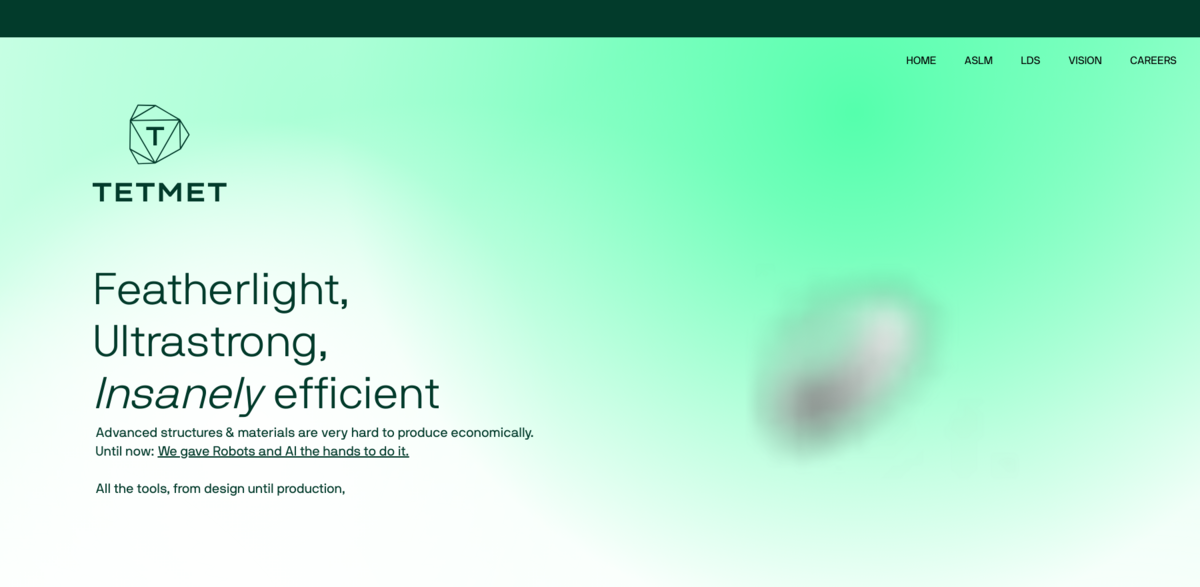What is the TETMET Project?
TETMET is revolutionizing the way advanced structures and materials are produced. For decades, architectured materials—especially lattices—have been hailed as the holy grail of materials science, offering unmatched efficiency in structuring. But until now, making these complex lattices at scale was a massive headache: costly, slow, and mostly stuck in research labs. Enter TETMET. They’ve handed robots and AI the tools to design and produce these intricate lattices economically and at scale. Their vertically integrated AI and Robotics platform, known as Adaptive Spatial Lattice Manufacturing (ASLM), is a game-changer. It enables decentralized production of lightweight, ultra-strong, large structures using minimal materials, energy, and machinery. From automotive to aviation, defense to energy, TETMET is unlocking new horizons in sustainable manufacturing.
Main Benefits of TETMET’s Technology
Here’s what makes TETMET stand out:
- Mass reduction of 60% to 80% compared to aluminum in many projects.
- Speedboat models using 40% less material, lighter and more eco-friendly without sacrificing strength.
- Airplane seats that are 60% lighter, boosting fuel efficiency and reducing environmental impact.
- Solar panel frames that consume 95% less energy during production, slashing carbon footprints.
- Laser spot-welding technology that uses negligible electricity, making production highly energy-efficient.
- Use of standard raw materials and components, allowing fast and scalable deployment.
How TETMET Bridges Design and Production
One of the biggest challenges in architectured materials was the lack of appropriate design tools. Without a reliable production method, no one had cracked the code for optimized lattice design—until TETMET stepped in. They developed their own design software tailored specifically for these complex structures. But they didn’t stop there. TETMET also created a unique production toolchain that leverages standard robotics, fiber lasers, and cameras to bring these designs to life. This seamless integration of design and manufacturing is what makes their approach so disruptive and efficient.
Applications Across Industries
The beauty of TETMET’s technology is its versatility. It’s not just for one sector—it’s making waves across automotive, aviation, space, construction, defense, and energy industries. Wherever metal parts are used, TETMET’s lattices can reduce weight dramatically while maintaining or even improving strength and performance. This means lighter vehicles, more fuel-efficient airplanes, stronger yet lighter building components, and more sustainable energy solutions. The potential for decarbonization and circularity is enormous.
The Team Behind the Innovation
TETMET’s engineering team is a powerhouse mix of PhDs, experienced entrepreneurs, lattice design experts, AI specialists, and roboticists. Together, they bring decades of knowledge and innovation to the table. Their combined expertise fuels the continuous improvement of ASLM technology and ensures that TETMET stays at the cutting edge of advanced materials manufacturing. Plus, their lab is right in the heart of La Grande Arche de la Défense, just 10 minutes from Paris center—where AI-powered robots and lasers work in harmony with the office environment. It’s a hub of innovation you can almost feel buzzing.
Project Impact on Sustainable Development Goals (SDGs)
- SDG 9: Industry, Innovation, and Infrastructure – through disruptive manufacturing technologies.
- SDG 11: Sustainable Cities and Communities – by enabling lighter, more efficient building materials.
- SDG 12: Responsible Consumption and Production – minimizing material and energy use.
- SDG 13: Climate Action – reducing carbon footprints across multiple industries.
- SDG 7: Affordable and Clean Energy – by improving energy efficiency in production and end products.
Looking Ahead: The Future of Manufacturing
TETMET’s approach isn’t just about making things lighter or stronger—it’s about fundamentally changing how materials are designed and produced. By combining AI, robotics, and advanced laser technology, they’re making sustainable manufacturing accessible and scalable. This means faster innovation cycles, less waste, and products that perform better while being kinder to the planet. As industries push for decarbonization and circularity, TETMET’s technology is poised to become a cornerstone of the next industrial revolution. The future looks lighter, stronger, and a whole lot smarter.





















